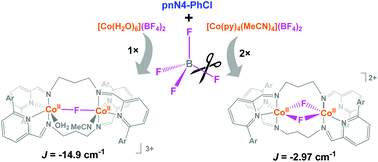Substituent effects of N4 Schiff base ligands on the formation of fluoride-bridged dicobalt(ii) complexes via B–F abstraction: structures and magnetism†
Abstract
We report the synthesis of two fluoride bridged cobalt(II) dimers – [CoII2(μ-F)(pnN4-PhCl)2(OH2)(MeCN)](BF4)3 (1) and [CoII2(μ-F)2(pnN4-PhCl)2](BF4)2 (2) – and related complexes derived from propyl-bridged N4 Schiff base plus pyridine ligands. Notably, the bridging fluoride ion(s) emanate from B–F abstraction processes on the BF4 anions in the starting salt, [Co(H2O)6](BF4)2. Two types of bridging motifs are generated – mono-bridged (μ-F) or di-bridged (μ-F)2 – synthetically differentiated by the absence or presence of pyridine, respectively, during metalation. The synergistic roles of pyridine and the ClPhN4 ligand in promoting B–F abstraction were clarified by the isolation and crystallization of the simple tetrakis-pyridine monomeric complex [Co(py)4(MeCN)2](BF4)2 (4) [no B–F abstraction]; subsequent addition of the ClPhN4 ligand to 4 resulted in formation of the dimeric, di-bridged complex 2. Omission of pyridine during metalation resulted in formation of the mono-bridged dimer 1. The bulky chlorophenyl substituents were obligate for B–F abstraction, as metalation of the unsubstituted N4 ligand resulted in the non-fluoride-bridged dimer, [CoII2(pnN4)3](BF4)4 (3). In magnetic studies, complexes 1 (μeff = 6.24μB, 298 K) and 2 (μeff = 7.70μB, 298 K) both exhibit antiferromagnetic (AFM) coupling, but to different extents. Temperature-dependent magnetic susceptibility measurements (SQUID, 2 → 300 K) reveal that the linearity of the mono-fluoride bridge in 1 [∠Co–F–Co = 159.47(11)°] results in very strong AFM coupling (J = −14.9 cm−1). In contrast, the more acute Co2F2 diamond core [∠Co–F–Co = 98.8(2)°, 99.1(2)°] results in a smaller extent of AFM coupling (J = −2.97 cm−1). Overall, the results indicate the ‘non-innocence’ of the BF4 counterion in cobalt(II) chemistry, and dimers 1 and 2 affirm the effect of the geometry of the bridging fluoride ion(s) in determining the extent of AFM coupling.


 Please wait while we load your content...
Please wait while we load your content...